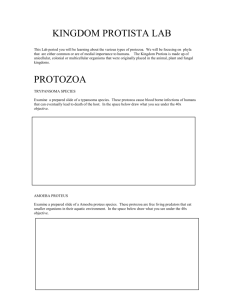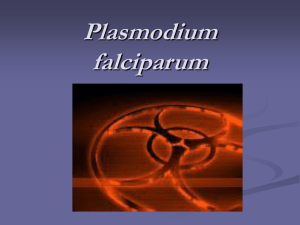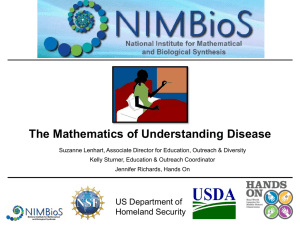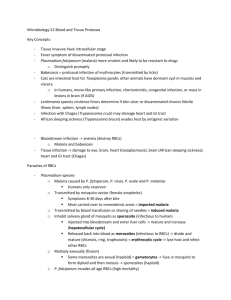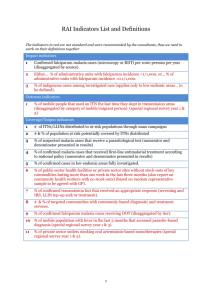Demonstration Sheets for Malaria (Apicomplexa Coccidea) (Lab 12)
advertisement
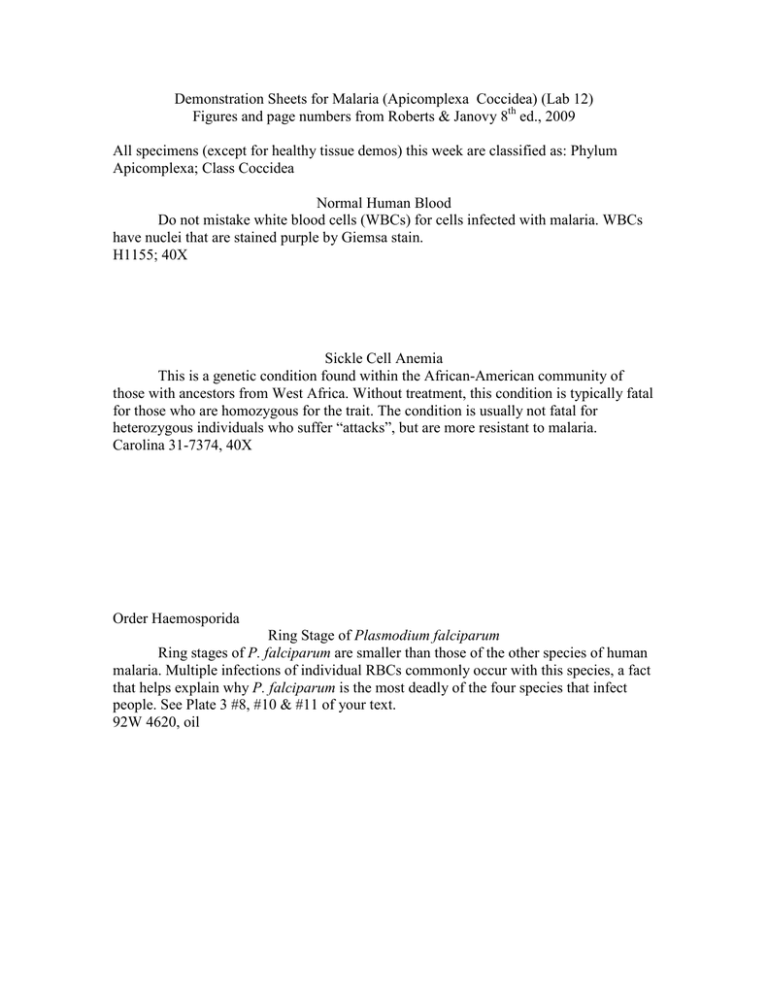
Demonstration Sheets for Malaria (Apicomplexa Coccidea) (Lab 12) Figures and page numbers from Roberts & Janovy 8th ed., 2009 All specimens (except for healthy tissue demos) this week are classified as: Phylum Apicomplexa; Class Coccidea Normal Human Blood Do not mistake white blood cells (WBCs) for cells infected with malaria. WBCs have nuclei that are stained purple by Giemsa stain. H1155; 40X Sickle Cell Anemia This is a genetic condition found within the African-American community of those with ancestors from West Africa. Without treatment, this condition is typically fatal for those who are homozygous for the trait. The condition is usually not fatal for heterozygous individuals who suffer “attacks”, but are more resistant to malaria. Carolina 31-7374, 40X Order Haemosporida Ring Stage of Plasmodium falciparum Ring stages of P. falciparum are smaller than those of the other species of human malaria. Multiple infections of individual RBCs commonly occur with this species, a fact that helps explain why P. falciparum is the most deadly of the four species that infect people. See Plate 3 #8, #10 & #11 of your text. 92W 4620, oil Order Haemosporida Ring Stage of Plasmodium vivax Early during development within host RBCs, malaria merozoites contain a vacuole that does not stain as well with Wright’s stain as does the nucleus. This gives the stage the appearance of a signet ring with the vacuole being the “hole” and the nucleus the “jewel” of the ring. Ring stages of P. vivax are much larger than those of P. falciparum and can almost completely fill the host RBC. See Plate 1 #5 & #12 in your text. 92W 4660, oil Order Haemosporida Cerebral Malaria Brain capillaries of host are blocked by red blood cells containing the parasites (recognized by the sequences of “dots” formed by stained circular parasites). The outer surfaces of parasitized red blood cells (RBCs) become “sticky” and adhere to capillary walls especially in the central nervous system. Parasitized cells that are anchored in this manner do not pass through the liver and spleen where damaged RBCs are removed from circulation. The impairment of circulation, however, increases the likelihood of stroke. See Figure 9.7 (p. 159). 92W 4700, 40X Healthy Liver Tissue One function of the liver is to remove toxins, such as hemozoin, from the blood. As a consequence, many chemical compounds are concentrated in this organ. This slide is presented for comparative purposes with the adjacent hemozoin slide. Carolina 31-5400, 40X Order Haemosporida Hemozoin The dark stains are NOT parasites but deposits of the iron-containing pigment hemozoin. The pigment is an end-product of the degradation of hemoglobin by the parasite. Recent evidence suggests that hemozoin inhibits the host’s immune response by slowing the replication of antibody producing cells. See Figure 9.6 (p. 158). 92W 4701, 40X Order Haemosporida Pregnancy and Malaria Placental tissue containing blood vessels of the mother that are filled with RBCs infected with malaria and vessels of the infant that are free of the parasite. Pregnant women are at especially high risk in malarious areas as their immune systems are compromised during their pregnancies. 92W 4707, 40X Order Haemosporida Gametocyte of Plasmodium falciparum Gametocytes of malaria fill and distort RBCs giving them a crescent-shaped appearance. Once formed, gametocytes do not undergo further divisions in the human host. It is the gametocytes that must be withdrawn from the peripheral blood during feeding of the vector in order to maintain the life-cycle. Ring-stages that are consumed by mosquitoes are digested. See Plate 3 #26 & #28 in your text. 92W 4623, oil Order Haemosporida Oocysts in hemocoel of Anopheles vector This is a slide of the stomach of an infected mosquito with the oocysts (containing sporozoites) developing outside the lumen in the body cavity. See Figure 9.3 (p. 153). PS 745, 10X
